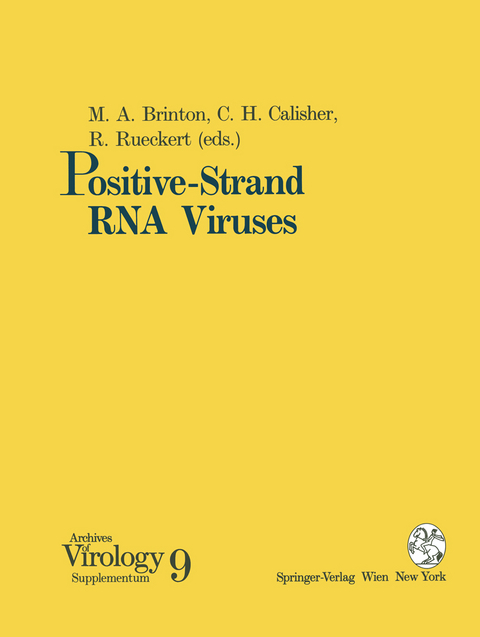
Positive-Strand RNA Viruses
Springer Wien (Verlag)
978-3-211-82522-8 (ISBN)
Keynote address.- The importance of antigenic variation in vaccine design.- Strategies for control of virus diseases.- The genetic and functional basis of HIV-1 resistance to nonnucleoside reverse transcriptase inhibitors.- Structure-based design of symmetric inhibitors of HIV-1 protease.- Age-dependent susceptibility to fatal encephalitis: alphavirus infection of neurons.- Principles and background for the construction of transgenic plants displaying multiple virus resistance.- The structure of an immunodominant loop on foot and mouth disease virus, serotype O1, determined under reducing conditions.- Immunopathologic mechanisms of dengue hemorrhagic fever and dengue shock syndrome.- Molecular aspects of pathogenesis and virulence.- Cardioviral poly(C) tracts and viral pathogenesis.- Transgenic mice and the pathogenesis of poliomyelitis.- Adaptation of positive-strand RNA viruses to plants.- A molecular genetic approach to the study of Venezuelan equine encephalitis virus pathogenesis.- Use of drug-resistance mutants to identify functional regions in picornavirus capsid proteins.- Flock house virus: a simple model for studying persistent infection in cultured Drosophila cells.- Genome replication and transcription.- Protein-protein interactions and glycerophospholipids in bromovirus and nodavirus RNA replication.- Characteristics of the poliovirus replication complex.- Secretory pathway function, but not cytoskeletal integrity, is required in poliovirus infection.- Role of sub-genomic minus-strand RNA in Coronavirus replication.- Common replication strategies emerging from the study of diverse groups of positive-strand RNA viruses.- Preferential replication of defective turnip yellow mosaic virus RNAs that express the 150-kDa protein in cis.- In vivo transfection by hepatitis A virus synthetic RNA.- RNA recombination.- Recombination between Sindbis virus RNAs.- Homologous RNA recombination allows efficient introduction of site-specific mutations into the genome of Coronavirus MHV-A59 via synthetic co-replicating RNAs.- Targeting of the site of nonhomologous genetic recombination in brome mosaic virus.- Natural recombination in bovine viral diarrhea viruses.- Sequences at the ends of RNA-2 of 16, a recombinant tobravirus.- RNA-protein interactions and host-virus interactions.- Identification and characterization of host factor interactions with cis-acting elements of rubella virus RNA.- Interaction of cellular proteins with the poliovirus 5? noncoding region.- IRES-controlled protein synthesis and genome replication of poliovirus.- Analysis of hepatitis A virus translation in a T7 polymerase-expressing cell line.- Purification and characterization of the U-particle, a cellular constituent whose synthesis is stimulated by mengovirus infection.- B-lymphocytes are predominantly involved in viral propagation of hepatitis C virus (HCV).- Protein expression and virion maturation.- Folding of the mouse hepatitis virus spike protein and its association with the membrane protein.- Assembly and entry mechanisms of Semliki Forest virus.- The interactions of the flavivirus envelope proteins: implications for virus entry and release.- Coronavirus polyprotein processing.- Processing of dengue type 4 and other flavivirus nonstructural proteins.- Nuclear targeting of Semliki Forest virus nsP2.- RNA replication.- Replication and translation of cowpea mosaic virus RNAs are tightly linked.- Alphavirus positive and negative strand RNA synthesis and the role of polyproteins in formation of viral replication complexes.- Nodavirus RNA replication:mechanism and harnessing to vaccinia virus recombinants.- Molecular characterization of Borna virus RNAs.- Genomic organization and expression of astroviruses and calciviruses.- Lelystad virus belongs to a new virus family, comprising lactate dehydrogenase- elevating virus, equine arteritis virus, and simian hemorrhagic fever virus.- Virus receptors.- Recognition of cellular receptors by bovine corona-virus.- Mouse hepatitis virus receptors: more than a single carcinoembryonic antigen.- Host-cell receptors for Sindbis virus.- Cell surface receptor for ecotropic host-range mouse retroviruses: a cationic amino acid transporter.- Virus structure and assembly.- Comparative studies of T = 3 and T = 4 icosahedral RNA insect viruses.- Retroviral RNA packaging: a review.- Structural studies of viruses by electron cryomicroscopy.- Crystallographic and cryo EM analysis of virion-receptor interactions.- Assembly of tobacco mosaic virus and TMV-like pseudovirus particles in Escherichia coli.
| Erscheint lt. Verlag | 16.3.1994 |
|---|---|
| Reihe/Serie | Archives of Virology. Supplementa |
| Zusatzinfo | X, 558 p. 183 illus. |
| Verlagsort | Vienna |
| Sprache | englisch |
| Maße | 210 x 279 mm |
| Gewicht | 1514 g |
| Themenwelt | Medizin / Pharmazie ► Medizinische Fachgebiete ► Mikrobiologie / Infektologie / Reisemedizin |
| Naturwissenschaften ► Biologie ► Mikrobiologie / Immunologie | |
| Schlagworte | Antigen • Cell • Hepatitis • Infection • pathogenesis • retroviruses • RNA • RNS (Ribonukleinsäure) • shock • Vaccine • Virologie • Virus |
| ISBN-10 | 3-211-82522-3 / 3211825223 |
| ISBN-13 | 978-3-211-82522-8 / 9783211825228 |
| Zustand | Neuware |
| Haben Sie eine Frage zum Produkt? |
aus dem Bereich


